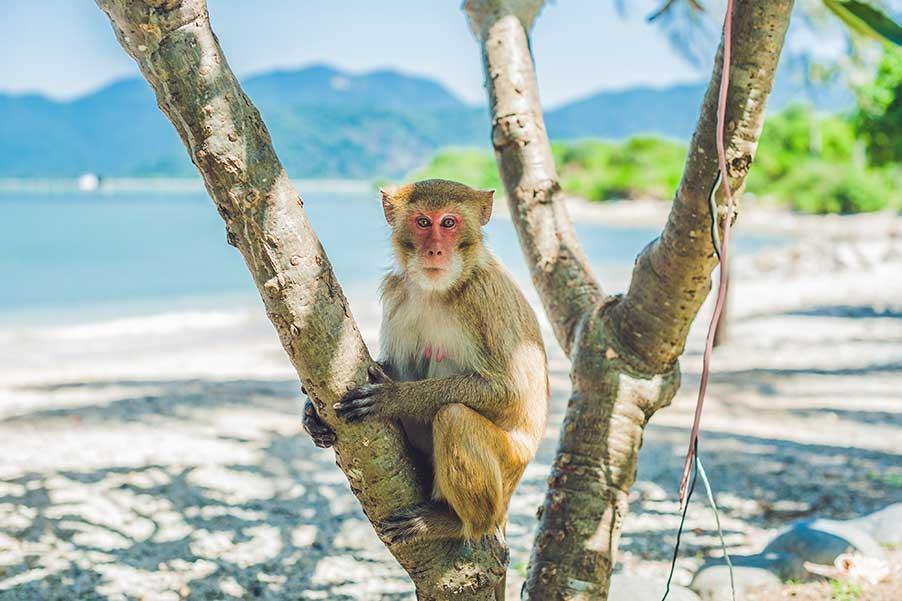Which Animals Live in Vietnam? A Small Overview

Vietnam's vibrant jungles are home to a wide array of wildlife, constantly surprising scientists with new species. From unknown cattle to majestic rhinos and playful monkeys, the country's fauna is as varied as its culture. Here, we'll introduce you to some of Vietnam's most fascinating jungle inhabitants.
Note: The diverse fauna is under threat from habitat destruction due to activities like slash-and-burn farming. Conservation efforts are crucial to preserving these ecosystems and the unique species they support.
Vietnam's Wildlife: The Macaque
Macaques are medium-sized primates found throughout Vietnam's forests. Known for their golden-brown fur and social nature, they form large groups and exhibit complex social behaviors. These groups play a critical role in the ecosystem by aiding seed dispersal and maintaining forest health.
Their omnivorous diet includes fruits, seeds, and small animals. However, habitat loss and hunting pose significant threats, making conservation efforts essential to their survival.
Unique Monkeys of Vietnam
Vietnam hosts several unique monkey species, including the striking Red-Shanked Douc and the elusive Snub-Nosed Monkey. These tree-dwelling primates are crucial for forest dynamics, helping with pollination and seed distribution. Their beautiful coloration and unique features make them a rare sight and a highlight for wildlife enthusiasts.
Sad but true: Many of these species are critically endangered due to deforestation and hunting, emphasizing the need for protective measures and habitat restoration.
Cute Yet Endangered: The Plumploris
Plumploris are nocturnal primates known for their slow movements and strong grip, allowing them to navigate trees easily. Despite their toxic bite, they are hunted due to superstitions and the exotic pet trade, which has led to a decline in their population.
Conservation programs are working to protect these unique creatures, focusing on habitat preservation and anti-poaching measures.
Other Notable Jungle Inhabitants
The rich biodiversity of Vietnam includes more than just primates:
- The Great Hornbill, with its impressive beak, plays a vital role in seed dispersal. Found in forests and hilly regions, its presence indicates healthy ecosystems. Bird species in Vietnam are incredibly diverse, adding vibrant life to the country's forests.
- The Indian elephant, smaller than its African cousin, is a symbol of strength and wisdom. Conservation areas in Dak Lak province offer a refuge for these majestic animals.
- The Vietnamese Mossy Frog, known for its camouflage, inhabits the rocky cliffs and caves of northern Vietnam. Its unique appearance helps it blend into its surroundings, avoiding predators.
- The Asian water monitor, a large lizard, thrives in the waterways of South and Southeast Asia. Its robust population supports local ecosystems by controlling pest populations.
- The Water Buffalo is an iconic animal often seen working alongside Vietnamese people in rice fields across central Vietnam and the Mekong Delta. As a national animal, it symbolizes resilience and hard work.
- Indochinese Tigers, another critically endangered species, are rare animals that require significant conservation efforts to prevent extinction. They are a symbol of Vietnam's wild heritage and require protected habitats to thrive.
With a Vietnam visa, you can explore this beautiful country and witness its diverse wildlife. National parks and conservation areas offer guided tours to educate visitors about the importance of preserving these natural habitats.
Vietnam's Colorful Wildlife
Vietnam's unique wildlife adds to its natural charm, though many species face threats from human activity. Protecting these ecosystems is crucial to preserving the country's biodiversity. Interested in exploring Vietnam's natural wonders? Apply for your Vietnam Visa online!
Created: 5/22/2020 | Modified: 1/2/2025
